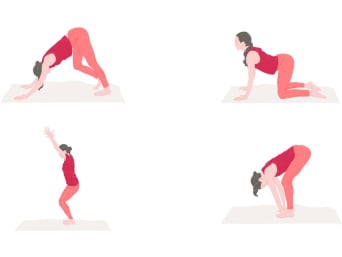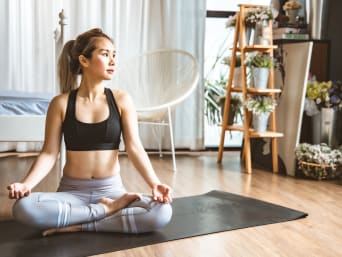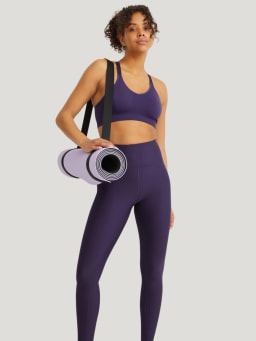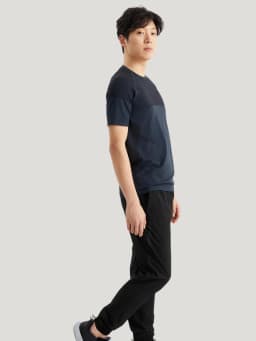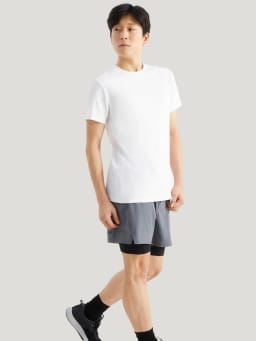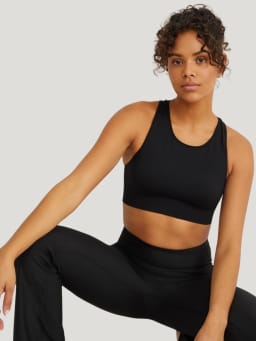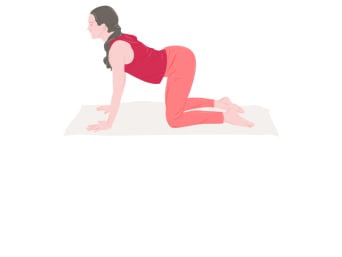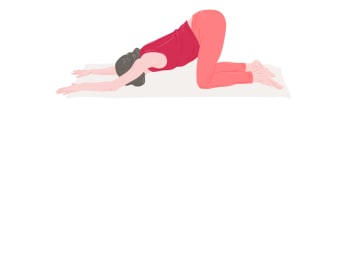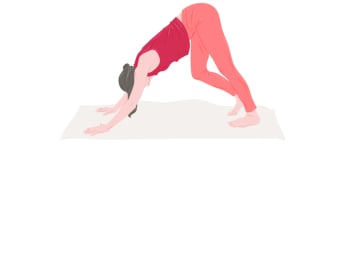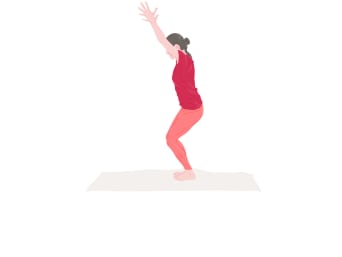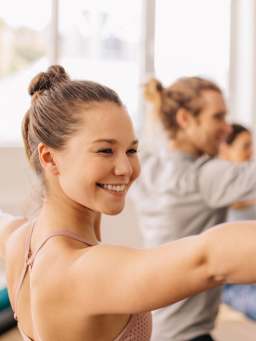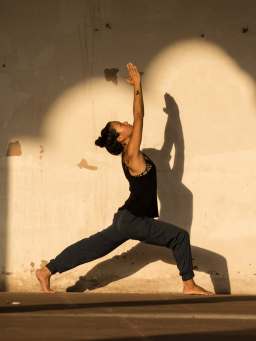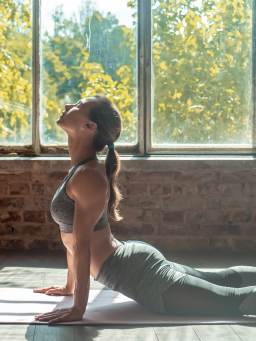Yoga at home: Simple yoga exercises for beginners
Yoga is known for its positive effect on the back and general posture. The ligaments and the spine are stretched during many exercises, and we become more aware of our bodies. This makes yoga the perfect sport for you if you must sit a lot in everyday life. In addition, yoga is perfect as a balance to other sports such as jogging, cycling, or weight training.
Here you will find a small yoga flow (series of yoga exercises) that you can do at home, which can easily be incorporated into your everyday life – even as a beginner. It strengthens your back and shoulders gently and beneficially. You can complete all seven yoga exercises within 10 minutes. This makes our yoga training for home a perfect start to the day, as it stretches your back and focuses your mind making you physically and mentally prepared for everyday life.
Table of contents
Yoga Exercise 1 – The Cat (Majariasana)
Yoga Exercise 2 – Extended Puppy Pose (Uttana Shishosana, Anahatasana)
Yoga Exercise 3 – The Downward Facing Dog (Adho Mukha Svanasana)
Yoga Exercise 4 – The Hand to Foot Pose (Pada Hastasana)
Yoga Exercise 5 – Mountain Pose (Tadasana)
Yoga Exercise 6 – The Chair (Utkatasana)
Yoga Exercise 7 – The Deep Relaxation
__________
Did you know that..
Correct execution is essential, especially if you suffer from back pain. Please consult a doctor, physiotherapist, or trained yoga instructor to avoid disappointment or injury.
__________
Yoga training: 7 yoga exercises to do at home
To remove the clutter from your mind and help prepare for the session, start with a simple meditation. Sit cross-legged on your yoga mat, relax your hands on your legs and close your eyes. Your back should be straight, and your shoulders relaxed. Wander mentally through your body for about 3 – 5 minutes and concentrate on your breathing until the thoughts of everyday life become a little quieter and you are ready for the yoga exercises to come.
__________
Did you know that..
Try to focus on your breathing during your little yoga workout. Your breath should flow deeply and gently. It sets the rhythm for your yoga exercises.
__________
Yoga exercise 1 – The cat (Majariasana)
This asana is widely known and very good for your back. It stretches your spine, provides flexibility, and prepares you for the upcoming yoga workout at home.
The starting position is on your hands and knees, with your hands shoulder-width apart and your knees under your hips. Spread your fingers flat on the mat, this will distribute your weight and give you more support. If it is uncomfortable for your knees, fold a blanket underneath. Your neck should be in line with your back, facing the floor.
Now take a deep breath and pull your shoulders back. Push your belly out, lift your head and look straight ahead. Be careful not to arch your back too much.
As you exhale, pull your belly button up, lower your head and make your back as round as possible – like a cat. Throughout the yoga exercise, keep your shoulders above your wrists and your hips above your knees.
Repeat 5 times in rhythm with your deep, calm breathing.
Tip: You should also wear sportswear when doing yoga at home. It allows you good freedom of movement and reduces the risk of injury.
Yoga exercise 2 – Extended puppy pose (Uttana Shishosana, Anahatasana)
The next exercise can be done in a flowing transition. It stretches the spine and relaxes the shoulders.
From the previous starting position, push the hands forward until your forearms are resting and your buttocks are pointing upwards. Your elbows should be approximately where your hands were before. Your legs remain at right angles and your hips are still aligned above your knees. Your forehead almost touches the mat during this yoga exercise.
Breathe in and out deeply. Keep your neck in a straight line with your spine. After about 5 breath cycles return to the hands and knees position.
Yoga exercise 3 – The downward facing dog (Adho Mukha Svanasana)
This exercise is probably the best-known asana. It stretches the whole body and strengthens your back and shoulders. If performed regularly, this exercise can counteract headaches and neck pain.
Starting from your hands and knees position, place your toes on the floor, inhale deeply and on the next exhale push your hips towards the sky. Your body now forms an inverted V. Your arms and legs should remain straight, and your back stretched out.
You can hold this position or walk on the spot with your feet to loosen your ligaments and tendons a little.
It doesn’t matter if your heels don’t touch the floor at first. Your flexibility will improve each time. Always make sure that your back and neck form a line and that you do the asanas and the transitions calmly and in rhythm with your breathing.
Yoga exercise 4 – The hand to foot pose (Pada Hastasana)
The next position strengthens your mind and trains your flexibility. It improves blood flow to the brain and stretches your ligaments. It grounds you mentally and physically through the pressure of your feet on the floor.
Starting from the downward-facing dog, slowly walk to the centre of the mat. Now bend over in front and touch your toes or embrace your lower legs. Your legs don’t have to be straight, just bend them in a relaxed way. But make sure to keep your back straight.
Consciously relax your shoulders and arms. If your neck tenses, you can turn your head a little to the right and left. Hold the exercise for 5 deep breaths.
__________
Did you know that..
The more flexible you become with regular yoga at home, the more intense this posture becomes. Experienced yogis can place their entire upper body against their legs.
__________
Yoga exercise 5 – Mountain pose (Tadasana)
Now slowly straighten your body – vertebra by vertebra – from the bottom to the top. At the end, push your shoulders back and circle them two or three times to arrive at the mountain position.
Place your feet together or hip-width apart, push your pelvis forward and avoid a hollow back. Keep your arms relaxed at your sides with the palms facing inwards. Inhale and exhale deeply.
When you are ready, spread your fingers and bring your hands up your body above your head. Press your feet firmly into the floor, lift your chest and stretch to your fingertips.
Look up at your hands and inhale and exhale deeply 3 times.
Exhaling slowly lower your arms and bring your hands together behind your back. Raise your hands behind your body and open your chest.
Mountain pose is one of the basic yoga postures and the starting position for many exercises. Correct execution and concentration on details are crucial. It improves your posture and awareness of your body.
Yoga Exercise 6 – The chair (Utkatasana)
The chair is an integral part of the well-known sun salutation and looks simpler than it is. Your posture is sustainably improved by the precise alignment of the pelvis and spine. Large muscles in the legs and back are strengthened.
Stand with your feet hip-width apart or together so that your big toes touch and there is a small gap between your heels. Keep your knees loose. Push your pelvis straight down a little so that your tailbone is straight to the floor, and you do not form a hollow back. Make sure your neck is in line with your back. You should notice your thighs working. Raise your arms shoulder-width apart and spread your fingers. Press your heels into the mat and hold the position for 5 deep breaths.
Yoga exercise 7 – The deep relaxation
There are different postures for deep relaxation at the end of each flow. The two best known are Savasana and Balasana.
For the Savasana exercise, start by lying flat on your back. Keep your legs straight and your feet pointing loosely outwards. Place your arms to your sides, stretched out a little. Make sure that your back forms a line, i.e. that your neck is not overstretched and that your back does not form a hollow back. When you have found a relaxed position, breathe deeply and regularly into the mat to calm your mind.
Conclusion
You can repeat this yoga workout at home as often as you like. It is perfect for beginners and a good basis for integrating more asanas into the flow. Practising yoga once a week can help you counteract back pain and make you feel fitter in general.
If you want to expand your knowledge, visit a yoga school near you or even take online yoga programmes. When choosing the right yoga class, you can think about which style of yoga you prefer beforehand. You can choose from classical yoga, yoga for relaxation and vigorous yoga styles for fitness enhancement.
______________________________________________
Sources
https://www.verywellfit.com/cat-cow-stretch-chakravakasana-3567178
(accessed 12.10.2021)
https://extendyoga.com/fun-pose-friday-puppy-pose/
(accessed 12.10.2021)
https://destinationyoga.co.uk/latest-news/poses/downward-dog/
(accessed 12.10.2021)
https://www.verywellfit.com/mountain-pose-tadasana-3567127
(accessed 12.10.2021)
https://www.verywellfit.com/work-your-core-with-standing-balance-yoga-poses-3567153
(accessed 12.10.2021)
https://www.yogawithcr.com/yoga-pose-for-deep-relaxation/
(accessed 12.10.2021)
Image source
iStock.com/anon-tae
